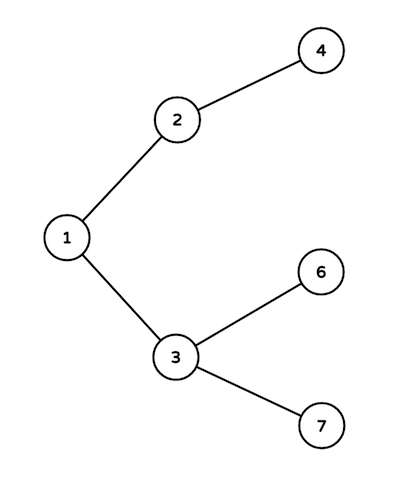CF696A Lorenzo Von Matterhorn
Barney lives in NYC. NYC has infinite number of intersections numbered with positive integers starting from 1. There exists a bidirectional road between intersections i and 2i and another road between i and 2i + 1 for every positive integer i. You can clearly see that there exists a unique shortest path between any two intersections.

Initially anyone can pass any road for free. But since SlapsGiving is ahead of us, there will q consecutive events happen soon. There are two types of events:
1. Government makes a new rule. A rule can be denoted by integers v, u and w. As the result of this action, the passing fee of all roads on the shortest path from u
2. Barney starts moving from some intersection v and goes to intersection u where there's a girl he wants to cuddle (using his fake name Lorenzo Von Matterhorn). He always uses the shortest path (visiting minimum number of intersections or roads) between two intersections.
Government needs your calculations. For each time Barney goes to cuddle a girl, you need to tell the government how much money he should pay (sum of passing fee of all roads he passes).
Input
The first line of input contains a single integer q (1 ≤ q ≤ 1 000).
The next q lines contain the information about the events in chronological order. Each event is described in form 1 v u w if it's an event when government makes a new rule about increasing the passing fee of all roads on the shortest path from u to v by w dollars, or in form 2 v u if it's an event when Barnie goes to cuddle from the intersection v to the intersection u.
1 ≤ v, u ≤ 1018, v ≠ u, 1 ≤ w ≤ 109 states for every description line.
Output
For each event of second type print the sum of passing fee of all roads Barney passes in this event, in one line. Print the answers in chronological order of corresponding events.
Example
Input
Copy
7 1 3 4 30 1 4 1 2 1 3 6 8 2 4 3 1 6 1 40 2 3 7 2 2 4
Output
Copy
94 0 32
Note
In the example testcase:
Here are the intersections used:

- Intersections on the path are 3, 1, 2 and 4.
- Intersections on the path are 4, 2 and 1.
- Intersections on the path are only 3 and 6.
- Intersections on the path are 4, 2, 1 and 3. Passing fee of roads on the path are 32, 32 and 30 in order. So answer equals to 32 + 32 + 30 = 94.
- Intersections on the path are 6, 3 and 1.
- Intersections on the path are 3 and 7. Passing fee of the road between them is 0.
- Intersections on the path are 2 and 4. Passing fee of the road between them is 32 (increased by 30 in the first event and by 2 in the second).
模擬就可以了;
我們可以O(log)的往上跳,先將兩個節點調至同一高度,然後同時跳即可;
#include<iostream>
#include<cstdio>
#include<algorithm>
#include<cstdlib>
#include<cstring>
#include<string>
#include<cmath>
#include<map>
#include<set>
#include<vector>
#include<queue>
#include<bitset>
#include<ctime>
#include<deque>
#include<stack>
#include<functional>
#include<sstream>
//#include<cctype>
//#pragma GCC optimize("O3")
using namespace std;
#define maxn 400005
#define inf 0x3f3f3f3f
#define INF 999999999999999
#define rdint(x) scanf("%d",&x)
#define rdllt(x) scanf("%lld",&x)
#define rdlf(x) scanf("%lf",&x)
#define rdstr(x) scanf("%s",x)
typedef long long ll;
typedef unsigned long long ull;
typedef unsigned int U;
#define ms(x) memset((x),0,sizeof(x))
const long long int mod = 1e9 + 7;
#define Mod 100003
#define sq(x) (x)*(x)
#define eps 1e-3
typedef pair<int, int> pii;
#define pi acos(-1.0)
const int N = 1005;
#define REP(i,n) for(int i=0;i<(n);i++)
inline ll rd() {
ll x = 0;
char c = getchar();
bool f = false;
while (!isdigit(c)) {
if (c == '-') f = true;
c = getchar();
}
while (isdigit(c)) {
x = (x << 1) + (x << 3) + (c ^ 48);
c = getchar();
}
return f ? -x : x;
}
ll gcd(ll a, ll b) {
return b == 0 ? a : gcd(b, a%b);
}
ll sqr(ll x) { return x * x; }
/*ll ans;
ll exgcd(ll a, ll b, ll &x, ll &y) {
if (!b) {
x = 1; y = 0; return a;
}
ans = exgcd(b, a%b, x, y);
ll t = x; x = y; y = t - a / b * y;
return ans;
}
*/
int n;
map<ll, ll>Map;
int Log2(ll x) {
int cnt = 0;
while (x) {
x /= 2; cnt++;
}
return cnt;
}
int main()
{
ios::sync_with_stdio(false);
//rdint(n);
cin >> n;
ll opt, u, v, w;
while (n--) {
// rdllt(opt);
cin >> opt;
if (opt == 1) {
cin >> u >> v >> w;
if (u < v)swap(u, v);
while (Log2(u) != Log2(v)) {
Map[u] += w; u /= 2;
}
while (u != v) {
Map[u] += w; Map[v] += w; u /= 2; v /= 2;
}
}
else {
cin >> u >> v; ll ans = 0;
if (u < v)swap(u, v);
while (Log2(u) != Log2(v)) {
ans += Map[u]; u /= 2;
}
while (u != v) {
ans += Map[u]; ans += Map[v]; u /= 2; v /= 2;
}
cout << ans << endl;
}
}
return 0;
}